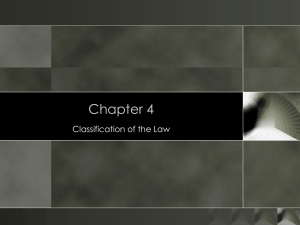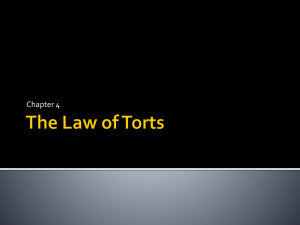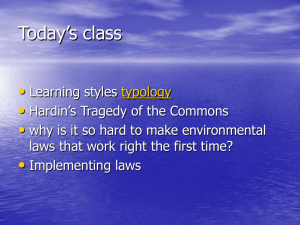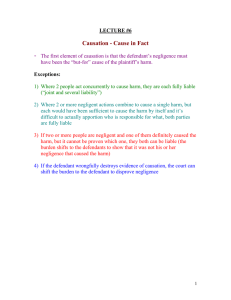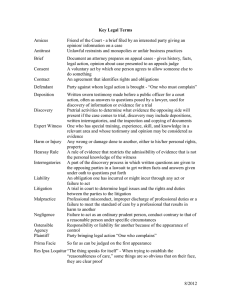Document
advertisement
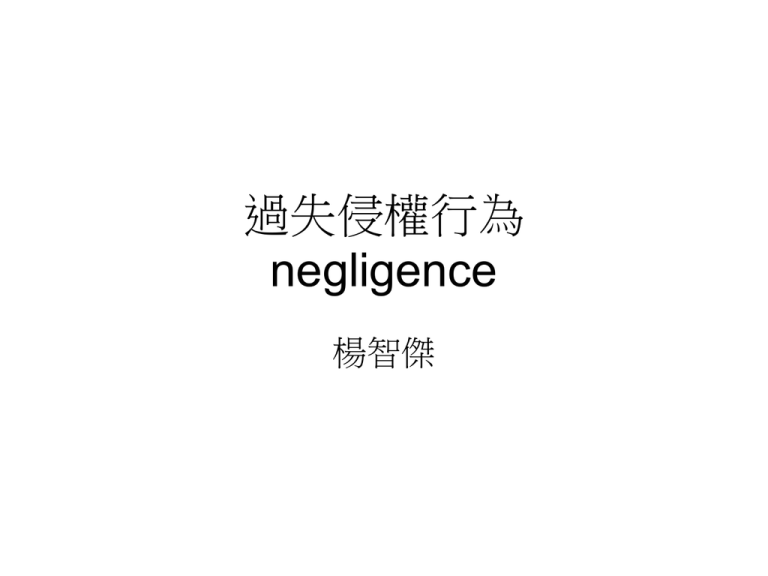
過失侵權行為 negligence 楊智傑 過失侵權的四要素 • A cause of action for negligence is frequently described as having four elements: – Duty – Breach – Causation – damage 義務duty的概念 • Palsgraf案 • A duty runs only to those who are within the foreseeable ambit of danger. • If there is “a risk reasonably to be perceived” to the plaintiff, there is a duty to be obeyed. The negligence Balancing Test • Nussbaum v. Lacopo案 • There is a remote possibility of personal injury or property damage is ordinarily not enough • Person cannot to be expected to guard against harm from events which are so unlikely to occur that the risk, although cognizable, would commonly be disregarded. 漢德公式 • United States v. Carroll Towing Co.案 • Learned Hand法官 • Liability exists if the burden the defendant would have to bear to avoid the risk (B) is outweighed by the gravity of the loss (L) times the probability (P) of the threatened harm (B<LP) 被告行為效益與是否存在替代行為 • The negligence inquiry also takes into account the utility of the defendant’s conduct and the availability of alternatives. 權衡分析法 • A balancing test may be employed to determine whether the defendant’s conduct has created an unreasonable risk of harm. • In general, the utility of the defendant’s action and the burden and feasibility of taking preventive measures are weighed against the gravity of the threatened harm and the probability that such harm will ensure 行為的效益 • The utility of a given course of conduct is a function of: – The social value of the interest the defendant seeks to advance – The likelihood that the conduct will advance the desired objective – The availability of alternative 替代行為 • Whether there is a viable alternative is a question of both technical feasibility and whether the alternative could entail high economic and non-economic costs 潛在危險的嚴重性 • The gravity of the threatened harm is a function of: – The social value of the interest imperiled – The extent of the harm that is threatened – The number of persons who are likely to be affected 通情達理之人(頁90) • The reasonable, prudent person is an entirely hypothetical character; thus, it is an error to tell jurors that the question for determination is whether they, as reasonable persons, would have done differently than the defendant. 宗教信仰拒絕輸血(頁92) • In Williams v. Bright, the issue was whether the plaintiff had unreasonably failed to mitigate(緩和) damages due to her religious beliefs as a Johovah’s Witness, which allegedly precluded her from having a knee operation because the procedure would require a blood transfusion. 精神缺陷(頁94) • Most jurisdictions hold that the fact that an actor is mentally deficient(缺陷), or temporarily or permanently insane(精神 錯亂), is normally not a relevant consideration in determining whether the actor behaved reasonably. 專門職業人員之不當執業 (professional malpractice)(頁96) • For example, a client(客戶) should not have to inquire whether a lawyer the client may hire believes that client information should be held confidential(保密), that conflicts of interest (利益衝突)should be avoided, or that it is necessary to do legal research before giving advice on an unsettled question of law. 法律不當執業(legal malpractice) (頁98) • If an attorney has failed to take appropriate action within the statute of limitations(時效), the plaintiff ordinarily must establish not only that the deadline was missed, but that had the statute not run, the plaintiff would have prevailed in the underlying action. 法律不當執業(legal malpractice) (頁98) • Transactional errors may entail a somewhat different approach to proof of causation(因果關係) of damage. For example, where a lawyer is negligent in arranging the sale of business, some courts allow the aggrieved(受侵害的) client to recover only if the client can show that but for the error there would have been a more advantageous result.


